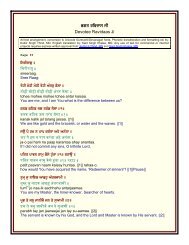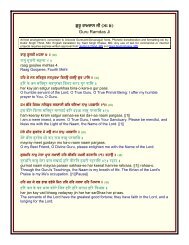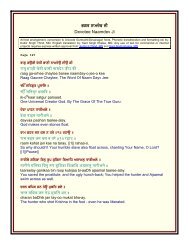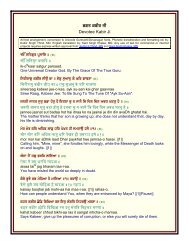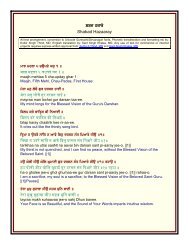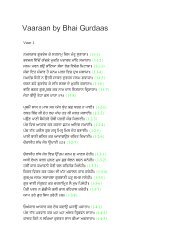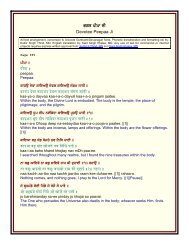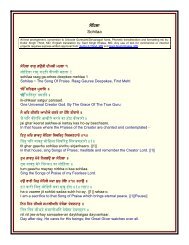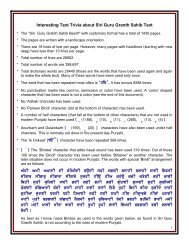Useful fonts manual - gurbanifile - Gurbanifiles.org
Useful fonts manual - gurbanifile - Gurbanifiles.org
Useful fonts manual - gurbanifile - Gurbanifiles.org
Create successful ePaper yourself
Turn your PDF publications into a flip-book with our unique Google optimized e-Paper software.
14<br />
(NOTE: The information that follows does not refer to the <strong>fonts</strong> inside the<br />
"Ramingt_" folder which are mapped according to the Ramington type writer<br />
key map that is in common use in India).<br />
1. Ease of Remembering the Gurmukhi Key Map on the Standard English Keyboard,<br />
both for Macintosh and IBM compatible PCs: This is not simple to achieve. Making<br />
it easier on one computer often makes it difficult on the other (for those characters<br />
in access of upper & lower case). For the upper & lower case characters, Dr. Thind<br />
adopted a technique that he calls “Phonetic Combining, Pairing & Associating.”<br />
The characters are mapped in a way that it makes it easier to remember their<br />
locations on the key map. Dr. Thind concludes from the received feed back, that<br />
this technique is well accepted. This scheme is not necessarily the most efficient<br />
for speed typing. However, most individuals are less concerned about designing<br />
key map to improve typing speed because most of them can type at very good<br />
speeds given any mapping. Experienced typists have no problem using the shift<br />
key to type any character and do so with efficiency.<br />
2. Easy Transferability of Files between Macintosh and IBM compatible PCs: This<br />
requirement limited Dr. Thind to use only certain character locations for characters<br />
in access of upper & lower case.<br />
3. Spell Checking & Flexible Search & Replace Functions: As of now, there are no<br />
Gurmukhi spell checking dictionaries available for the common user, something<br />
worth achieving particularly for our future generations growing up in the western<br />
part of the world. Thus, it is also important that character mapping be such that<br />
intended Gurmukhi dictionary words are recognized by the computer software as<br />
the dictionary characters. The key mapping for Amrit-Lipi has been somewhat<br />
deficient in this regard. This situation has been improved in the Gurmukhi <strong>fonts</strong> on<br />
the Gurbani-CD. Similar value has to be given to various “Search & Replace”<br />
functions. Thus Dr. Thind has attempted to use natural locations for those<br />
characters that also exist in the English <strong>fonts</strong>. Character locations for non<br />
dictionary characters (such as . , ; : < > ( )[ ] { } - _ = + ! # % $ *) can not be used<br />
for dictionary characters if Spell Checking and flexible Search & Replace functions<br />
are to be done with a reasonable ease. (NOTE: Devanagari <strong>fonts</strong> have too many<br />
characters making it difficult to achieve this goal).<br />
4. Issues of Quote Characters: Most people love to use smart or curly quote<br />
characters (“ ” ‘ ’) instead of regular quote characters (" ') for English as well as for<br />
Gurmukhi/Hindi writing. Most popular word processors have the option of<br />
automatic insertion of curly quotes (‘’ & “ ”) when using those keys for straight<br />
quotes. This is a function that most people love to use as it simplifies the use of<br />
double or single curly/smart quote characters. By using this automation process,<br />
one is able to use four of these curly quote characters with just one key with the<br />
help of the shift key. Thus it will be a problem using this key location for any thing<br />
All rights are reserved by the author, Kulbir S Thind, MD, 3724 Hacienda Street, San Mateo, CA 94403, USA.



